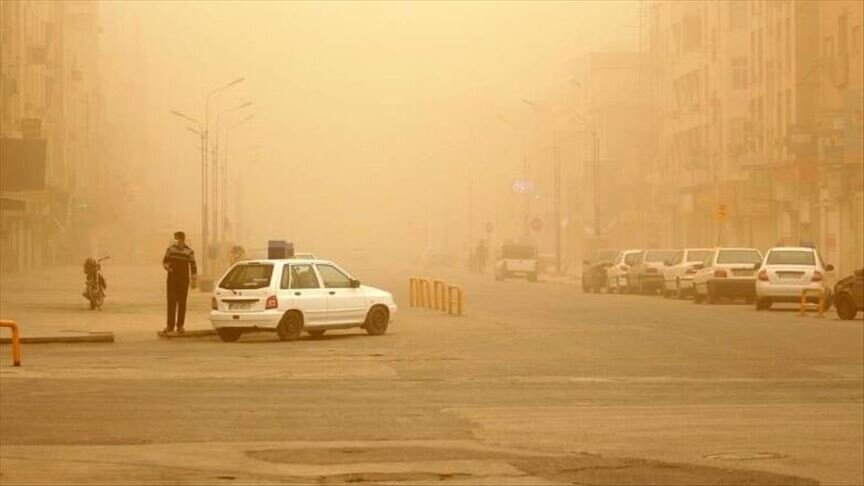$370m spent to counter SDSs in 3 years

TEHRAN – Over the past three years, the government has spent about $370 million from the National Development Fund on fighting sand and dust storms (SDSs), Ali Mohammad Tahmasebi, head of the national working group for SDSs mitigation, said.
Since the past few years, southern and western provinces of the country are frequently hit by sand and dust storms, as well as drought and even destructive floods, which is caused by both internal and external hotpots; major external SDSs sources are Syria, Saudi Arabia, and Iraq.
In fact, Iran has been repeatedly exposed to SDSs due to its presence in the arid and semi-arid part of the world, so that in 2006-2007, the dust storms originating in Iraq and Syria affected Iran, haunting a wide area of the country so that it reached the central areas and southern slopes of Alborz and also included Tehran.
Consumption, changing the pattern of cultivation, and climate change have increased the negative effects of this phenomenon.
One of the key steps we have taken is to identify dust hotspots and specify the intensity of dust generation in those areas, Tahmasebi stated.
After nearly two years, we identified areas with very low to very high dust potential, through which about 57 million hectares annually produce about 5 million tons of dust, and scatter about 8 kilograms of dust per hectare in the air, he noted.
He went on to say that in the next step, parts that could be considered permissible were removed, so important dust sources in 23 provinces estimated at 34.7 million hectares, with an average amount of 4.24 million tons of dust per year, of which 122.7 kilograms of dust per hectare is raised annually.
The 23 provinces affected by SDSs are located in the south, southeast, center, and parts of the west, 9 provinces of which are hit by 80 percent of the SDSs, and the most severe in terms of quantity and quality includes the provinces of Kerman, South Khorasan, Sistan-Baluchestan, Yazd, Semnan, Isfahan, Khorasan Razavi, Khuzestan, and Hormozgan, respectively, he noted.
We conducted another study and found that nearly 5.8 million hectares, amounting to 17 percent of the hotspots, are located in protected areas, he further stated.
About 19 million hectares of surrounding countries affect Iran, which is mainly raised from Iraq, Syria, Saudi Arabia, Afghanistan, the United Arab Emirates, Oman, and Turkmenistan, he noted.
Over the past three years, some $370 million have been spent to mitigate SDS hotspots in the country, he said.
During this period, about 110,000 hectares undergone seedling plantation, more than 750,000 hectares of protection, trapping and grazing operations in pastures with dust-raising potential, soil stabilization in 150,000 hectares, including mulching, construction of live and non-living windbreaks, equipping 100 stations for forecasting and warning, about 360 thousand cubic meters of dredging operations, improving routes for water to reach wetlands and about 100 kilometers of water transmission channels to humidify areas with dust potential in 27 dusty provinces were among the actions have been taken, he explained.
The national working group for the mitigation of SDSs has also taken a series of measures, including 39 meetings of the national and specialized committees and 45 meetings of related working groups, and several provincial working group meetings in 20 provinces, he noted.
One of the problems we have is that cooperation between responsible bodies is very difficult, and the organizations do not give us a comprehensive report, he concluded.
According to the World Metrological Organization, sand and dust storms usually occur when strong winds lift large amounts of sand and dust from bare, dry soils into the atmosphere. Over the last decade, scientists have come to realize the impacts on climate, human health, the environment, and many socio-economic sectors.
How to mitigate the effects of SDSs
According to EcoMENA, sand and dust storms cause significant negative impacts on society, economy, and environment at local, regional and global scales. There are three key factors responsible for the generation of sand and dust storms – strong wind, lack of vegetation, and absence of rainfall. The environmental and health hazards of such storms cannot be reduced permanently, however, its impact can be reduced by taking appropriate measures.
As the dust cloud rises, it reduces horizontal visibility which can impact human life in many ways. The fine suspended particles also contain contaminants, bacteria, pollens, which cause negative health impacts such as allergies and respiratory diseases. Dust also carries airborne pollutants such as toxins, heavy metals, salt, sulphur, pesticides, etc. which cause significant health impacts when people inhale the contaminated dust. Dust can corrode buildings and other built infrastructure as it contains a high level of salts.
The effects of sand and dust storms can be reduced by using a number of health and safety measures and environmental control strategies. Large-scale sand and dust storms are generally natural phenomena and it may not be always practicable to prevent it happening. However, control measures can be taken to reduce their impacts. Localized small-scale dust emission due to human-induced activities can be reduced by using temporary mechanical methods such as concrete barrier, mulching, tree buffer, etc.
Taking appropriate control of dust raising factors such as increasing the vegetation cover where possible can help in the stabilization of the soil, sand dunes, and form windbreaks. Additionally, the use of native plants and trees as the buffer can reduce wind velocity, and sand drifts at the same increase the soil moisture. Designing buildings appropriately and conduct air infiltration testing during building commissioning can also help the adverse effects of sand and dust storm.
FB/MG
Leave a Comment